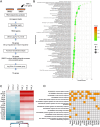Macrophages modulate mesenchymal stem cell function via tumor necrosis factor alpha in tooth extraction model
- PMID: 39086598
- PMCID: PMC11289833
- DOI: 10.1093/jbmrpl/ziae085
Macrophages modulate mesenchymal stem cell function via tumor necrosis factor alpha in tooth extraction model
Abstract
Mesenchymal stem cells (MSCs) and macrophages collaboratively contribute to bone regeneration after injury. However, detailed mechanisms underlying the interaction between MSCs and inflammatory macrophages (M1) remain unclear. A macrophage-depleted tooth extraction model was generated in 5-wk-old female C57BL/6J mice using clodronate liposome (12.5 mg/kg/mouse, intraperitoneally) or saline injection (control) before maxillary first molar extraction. Mice were sacrificed on days 1, 3, 5, 7, and 10 after tooth extraction (n = 4). Regenerated bone volume evaluation of tooth extraction socket (TES) and histochemical analysis of CD80+M1, CD206+M2 (anti-inflammatory macrophages), PDGFRα+MSC, and TNF-α+ cells were performed. In vitro, isolated MSCs with or without TNF-α stimulation (10 ng/mL, 24 h, n = 3) were bulk RNA-sequenced (RNA-Seq) to identify TNF-α stimulation-specific MSC transcriptomes. Day 7 micro-CT and HE staining revealed significantly lower mean bone volume (clodronate vs control: 0.01 mm3 vs 0.02 mm3, p<.0001) and mean percentage of regenerated bone area per total TES in clodronate group (41.97% vs 54.03%, p<.0001). Clodronate group showed significant reduction in mean number of CD80+, TNF-α+, PDGFRα+, and CD80+TNF-α+ cells on day 5 (306.5 vs 558.8, p<.0001; 280.5 vs 543.8, p<.0001; 365.0 vs 633.0, p<.0001, 29.0 vs 42.5, p<.0001), while these cells recovered significantly on day 7 (493.3 vs 396.0, p=.0004; 479.3 vs 384.5, p=.0008; 593.0 vs 473.0, p=.0010, 41.0 vs 32.5, p=.0003). RNA-Seq analysis showed that 15 genes (|log2FC| > 5.0, log2TPM > 5) after TNF-α stimulation were candidates for regulating MSC's immunomodulatory capacity. In vivo, Clec4e and Gbp6 are involved in inflammation and bone formation. Clec4e, Gbp6, and Cxcl10 knockdown increased osteogenic differentiation of MSCs in vitro. Temporal reduction followed by apparent recovery of TNF-α-producing M1 macrophages and MSCs after temporal macrophage depletion suggests that TNF-α activated MSCs during TES healing. In vitro mimicking the effect of TNF-α on MSCs indicated that there are 15 candidate MSC genes for regulation of immunomodulatory capacity.
Keywords: cytokines; dental biology; injury healing; osteoimmunology; stem cells.
© The Author(s) 2024. Published by Oxford University Press on behalf of the American Society for Bone and Mineral Research.
Conflict of interest statement
The authors declare no conflicts of interest.
Figures







Similar articles
-
Mesenchymal stem cells ameliorate rhabdomyolysis-induced acute kidney injury via the activation of M2 macrophages.Stem Cell Res Ther. 2014 Jun 24;5(3):80. doi: 10.1186/scrt469. Stem Cell Res Ther. 2014. PMID: 24961539 Free PMC article.
-
Mesenchymal stem cells protect renal tubular cells via TSG-6 regulating macrophage function and phenotype switching.Am J Physiol Renal Physiol. 2021 Mar 1;320(3):F454-F463. doi: 10.1152/ajprenal.00426.2020. Epub 2021 Feb 8. Am J Physiol Renal Physiol. 2021. PMID: 33554782 Free PMC article.
-
[MicroRNA-204 Carried by Exosomes of Human Umbilical Cord-derived Mesenchymal Stem Cells Regulates the Polarization of Macrophages in a Mouse Model of Myocardial Ischemia-reperfusion Injury].Zhongguo Yi Xue Ke Xue Yuan Xue Bao. 2022 Oct;44(5):785-793. doi: 10.3881/j.issn.1000-503X.14631. Zhongguo Yi Xue Ke Xue Yuan Xue Bao. 2022. PMID: 36325775 Chinese.
-
Bone regeneration in inflammation with aging and cell-based immunomodulatory therapy.Inflamm Regen. 2023 May 25;43(1):29. doi: 10.1186/s41232-023-00279-1. Inflamm Regen. 2023. PMID: 37231450 Free PMC article. Review.
-
The role of TNF-α in the fate regulation and functional reprogramming of mesenchymal stem cells in an inflammatory microenvironment.Front Immunol. 2023 Feb 6;14:1074863. doi: 10.3389/fimmu.2023.1074863. eCollection 2023. Front Immunol. 2023. PMID: 36814921 Free PMC article. Review.
References
-
- Pahwa R, Goyal A, Jialal I. Chronic inflammation. In: StatPearls [Internet]. Treasure Island (FL): StatPearls Publishing; 2023: http://www.ncbi.nlm.nih.gov/books/NBK493173/.
LinkOut - more resources
Full Text Sources

